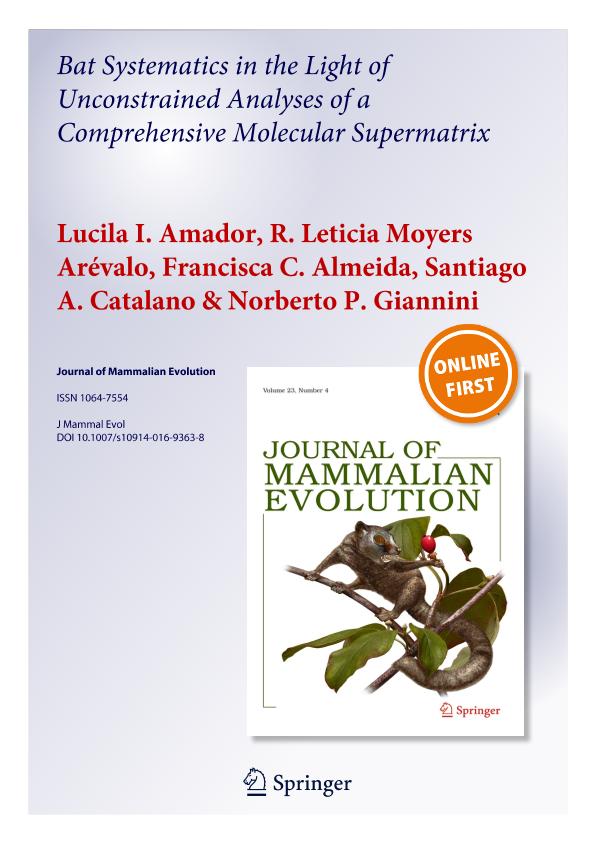Mostrar el registro sencillo del ítem
dc.contributor.author
Amador, Lucila Inés

dc.contributor.author
Moyers Arévalo, Reyna Leticia

dc.contributor.author
Cunha Almeida, Francisca

dc.contributor.author
Catalano, Santiago Andres

dc.contributor.author
Giannini, Norberto Pedro

dc.date.available
2018-08-15T18:15:02Z
dc.date.issued
2018-03
dc.identifier.citation
Amador, Lucila Inés; Moyers Arévalo, Reyna Leticia; Cunha Almeida, Francisca; Catalano, Santiago Andres; Giannini, Norberto Pedro; Bat Systematics in the Light of Unconstrained Analyses of a Comprehensive Molecular Supermatrix; Springer; Journal of Mammalian Evolution; 25; 1; 3-2018; 37-70
dc.identifier.issn
1064-7554
dc.identifier.uri
http://hdl.handle.net/11336/55671
dc.description.abstract
Bats (Chiroptera) represent the largest diversification of extant mammals after rodents. Here we report the results of a large-scale phylogeny of bats based on unconstrained searches for a data matrix of 804 non-chimeric, taxonomically updated bat terminals (796 species represented by a single terminal plus three species represented by ≥2 genetically distinct subspecies), able to preliminary test the systematics of most groups simultaneously. We used nine nuclear and mitochondrial DNA sequence markers fragmentary represented for ingroups (c. 90% and 64% of extant diversity at genus and species level, respectively) and 20 diverse placental outgroups. Maximum Likelihood and Parsimony analyses applied to the concatenated dataset yielded a highly resolved, variously supported phylogeny that recovered the majority of currently recognized clades at all levels of the chiropteran tree. Calibration points based on 44 key fossils allowed the Bayesian dating of bat origins at c. 4 my after the K-Pg boundary, and the determination of stem and crown ages of intraordinal clades. As expected, bats appeared nested in Laurasiatheria and split into Yinpterochiroptera and Yangochiroptera. More remarkable, all polytypic, currently recognized families were monophyletic, including Miniopteridae, Cistugidae, and Rhinonycteridae, as well as most polytypic genera with few expected exceptions (e.g., Hipposideros). The controversial Myzopodidae appeared in a novel position as sister of Emballonuroidea―a result with interesting biogeographic implications. Most recently recognized subfamilies, genera, and species groups were supported or only minor adjustments to the current taxonomy would be required, except Molossidae, which should be revised thoroughly. In light of our analysis, current bat systematics is strongly supported at all levels; the emergent perception of a strong biogeographic imprint on many recovered bat clades is emphasized.
dc.format
application/pdf
dc.language.iso
eng
dc.publisher
Springer

dc.rights
info:eu-repo/semantics/openAccess
dc.rights.uri
https://creativecommons.org/licenses/by-nc-sa/2.5/ar/
dc.subject
Chiroptera
dc.subject
Maximum Likelihood
dc.subject
Molecular Dating
dc.subject
Parsimony
dc.subject
Phylogeny
dc.subject.classification
Otras Ciencias Biológicas

dc.subject.classification
Ciencias Biológicas

dc.subject.classification
CIENCIAS NATURALES Y EXACTAS

dc.title
Bat Systematics in the Light of Unconstrained Analyses of a Comprehensive Molecular Supermatrix
dc.type
info:eu-repo/semantics/article
dc.type
info:ar-repo/semantics/artículo
dc.type
info:eu-repo/semantics/publishedVersion
dc.date.updated
2018-08-15T14:20:55Z
dc.journal.volume
25
dc.journal.number
1
dc.journal.pagination
37-70
dc.journal.pais
Estados Unidos

dc.journal.ciudad
Nueva York
dc.description.fil
Fil: Amador, Lucila Inés. Consejo Nacional de Investigaciones Científicas y Técnicas. Centro Científico Tecnológico - Tucumán. Unidad Ejecutora Lillo; Argentina
dc.description.fil
Fil: Moyers Arévalo, Reyna Leticia. Consejo Nacional de Investigaciones Científicas y Técnicas. Centro Científico Tecnológico - Tucumán. Unidad Ejecutora Lillo; Argentina
dc.description.fil
Fil: Cunha Almeida, Francisca. Consejo Nacional de Investigaciones Científicas y Técnicas. Oficina de Coordinación Administrativa Ciudad Universitaria. Instituto de Ecología, Genética y Evolución de Buenos Aires. Universidad de Buenos Aires. Facultad de Ciencias Exactas y Naturales. Instituto de Ecología, Genética y Evolución de Buenos Aires; Argentina
dc.description.fil
Fil: Catalano, Santiago Andres. Consejo Nacional de Investigaciones Científicas y Técnicas. Centro Científico Tecnológico - Tucumán. Unidad Ejecutora Lillo; Argentina. Universidad Nacional de Tucumán. Facultad de Ciencias Naturales e Instituto Miguel Lillo; Argentina
dc.description.fil
Fil: Giannini, Norberto Pedro. Consejo Nacional de Investigaciones Científicas y Técnicas. Centro Científico Tecnológico - Tucumán. Unidad Ejecutora Lillo; Argentina. Universidad Nacional de Tucumán. Facultad de Ciencias Naturales e Instituto Miguel Lillo; Argentina. American Museum of Natural History ; Estados Unidos
dc.journal.title
Journal of Mammalian Evolution

dc.relation.alternativeid
info:eu-repo/semantics/altIdentifier/doi/https://dx.doi.org/10.1007/s10914-016-9363-8
dc.relation.alternativeid
info:eu-repo/semantics/altIdentifier/url/https://link.springer.com/article/10.1007%2Fs10914-016-9363-8
Archivos asociados
